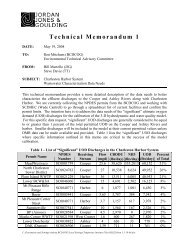Town of Summerville Planning Area - BCD Council of Governments
Town of Summerville Planning Area - BCD Council of Governments
Town of Summerville Planning Area - BCD Council of Governments
- No tags were found...
You also want an ePaper? Increase the reach of your titles
YUMPU automatically turns print PDFs into web optimized ePapers that Google loves.
Land UseDensity BonusesDensity ZoningInfill ZoningOverlay ZoningWatershed Based ZoningSources: Taming Stormwater Toolbook, <strong>BCD</strong>COGZoning TechniquesCompatible and functionally related land uses may reduce dependenceon automobiles and the impervious cover they require.Development that voluntarily meets certain performance standardsabove and beyond the minimum standards set forth in a community'szoning and land use regulations may be allowed to build at a greaterdensity within the project area than otherwise allowed.Density Zoning Regulations are land use regulations that look at thedevelopment intensity on the site as a whole, rather than the minimumlot size requirements, allowing for compact development whileprotecting key natural features on a site.Infill Zoning promotes dense development <strong>of</strong> various land uses in andadjacent to existing development where infrastructure already is inplace. The Future Land Use Element recommends strategies related toinfill zoning in several sections <strong>of</strong> the <strong>Summerville</strong> <strong>Planning</strong> <strong>Area</strong>.Overlay zones are zoning districts that impose or relax an additional set<strong>of</strong> requirements on an underlying zoning district to address localizedneeds. Overlay zones have been recommended as part <strong>of</strong> thedeveloping a master plan for the five Priority Investment <strong>Area</strong>sidentified in the Priority Investment <strong>Area</strong>s ElementWatershed based zoning uses use subwatershed boundaries for futureland use decisions.FloodplainsThe Berkeley Dorchester Hazard Mitigation Plan, originally passed in 2004 and updated in 2010, showsthat due to the setting <strong>of</strong> much <strong>of</strong> the <strong>Planning</strong> <strong>Area</strong> on sand hills at a higher elevation than in most <strong>of</strong>the metro Charleston region; most <strong>of</strong> <strong>Planning</strong> <strong>Area</strong> is not located in the 100‐year floodplain. However, aportion <strong>of</strong> the <strong>Summerville</strong> <strong>Planning</strong> <strong>Area</strong> located near the Ashley River is located within the floodplainarea. More importantly, due to the large amount <strong>of</strong> development that has taken place in within the<strong>Summerville</strong> <strong>Planning</strong> <strong>Area</strong> over the last 40 or so years and the subsequent amount <strong>of</strong> impervioussurfaces that have been created by the development, a number <strong>of</strong> sections <strong>of</strong> the <strong>Planning</strong> <strong>Area</strong> aresusceptible to flash flooding.In order to limit the impact <strong>of</strong> development to floodplain areas and watersheds, property owners andresidents can utilize several methods <strong>of</strong> mitigation. Some <strong>of</strong> these are:Rain gardens are designed to limit storm water impacts to the regional system at the local level throughgarden design and the utilization <strong>of</strong> plants that can withstand a variety <strong>of</strong> water conditions. In concertwith this, property owners can also utilize rain barrels or cisterns to collect rain water for use at a latertime. An example <strong>of</strong> a rain garden is seen in Figure NR1.Natural Resources Element Page 3




